Jerez de la Frontera is known as the heart of the sherry region and as budding sherry aficionados ourselves we clearly had to pay it a visit. We only spent 24 hours in Jerez but we tasted a lot of sherry, had delicious food and had a great time. What’s not to love!
Cafetería Churrería Julio Alacant, c. Doña Blanca, 24, 11402, Jerez de la Frontera


We landed in the morning and drove straight to the city just in time for the second breakfast which we promptly proceeded to find just around the corner from our hotel. For clarification, at this point in total, I have had churros 4 or 5 times in Spain and these dainty looking things have been hands down the best churros I have ever had. They were very thin, incredibly crispy with a little soft centre and they had a little bit of saltiness in them. It was fantastic. I have never had “salty” churros before and now I know what I am missing most of the time. Two coffees (€1.30 each), one portion of churros (€1.50) and the extravagantly expensive (€2.50) chocolate cost us €6.30 in total and we were off to a great start. 10/10 would recommend!
El Tabanco, calle Arcos, 42, 11401, Jerez de la Frontera
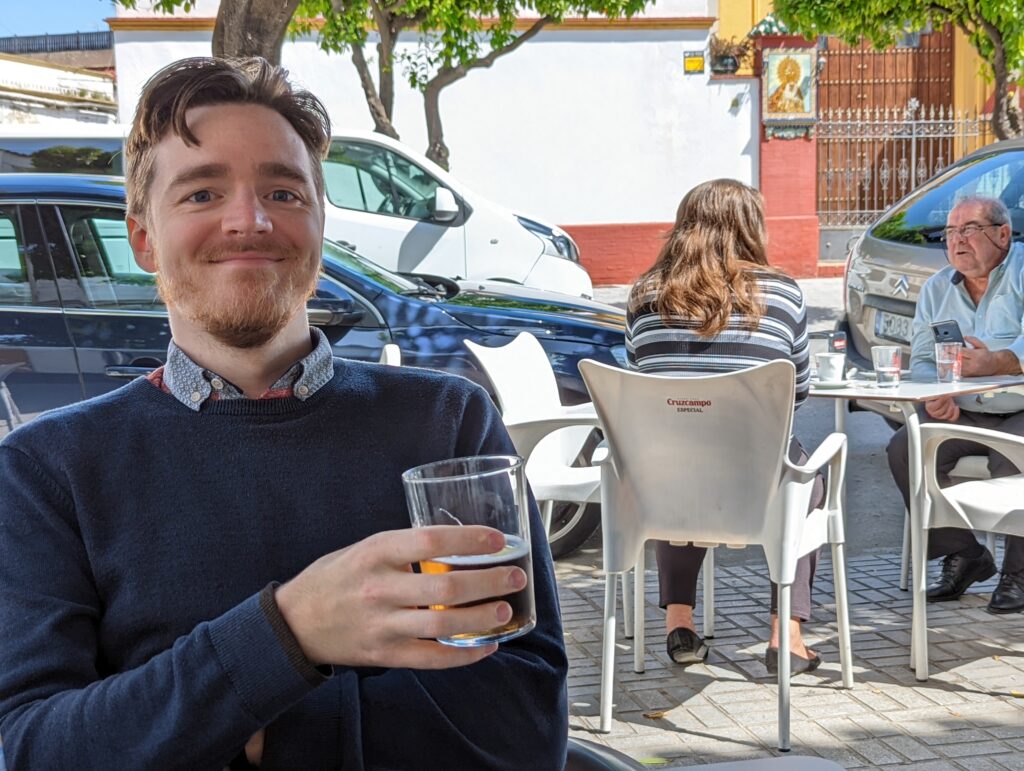
We chose to have lunch at El Tabanco solely because they were the only establishment open before lunch time and they provided a convenience of being located just in front of our first sherry degustation destination in Jerez.
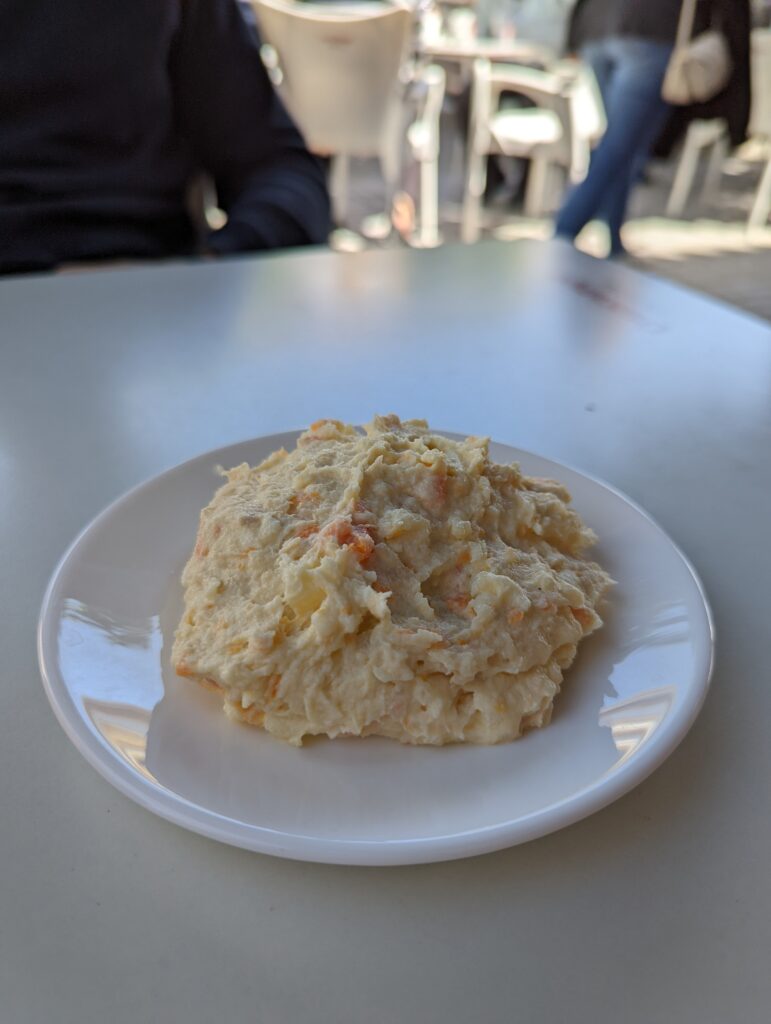
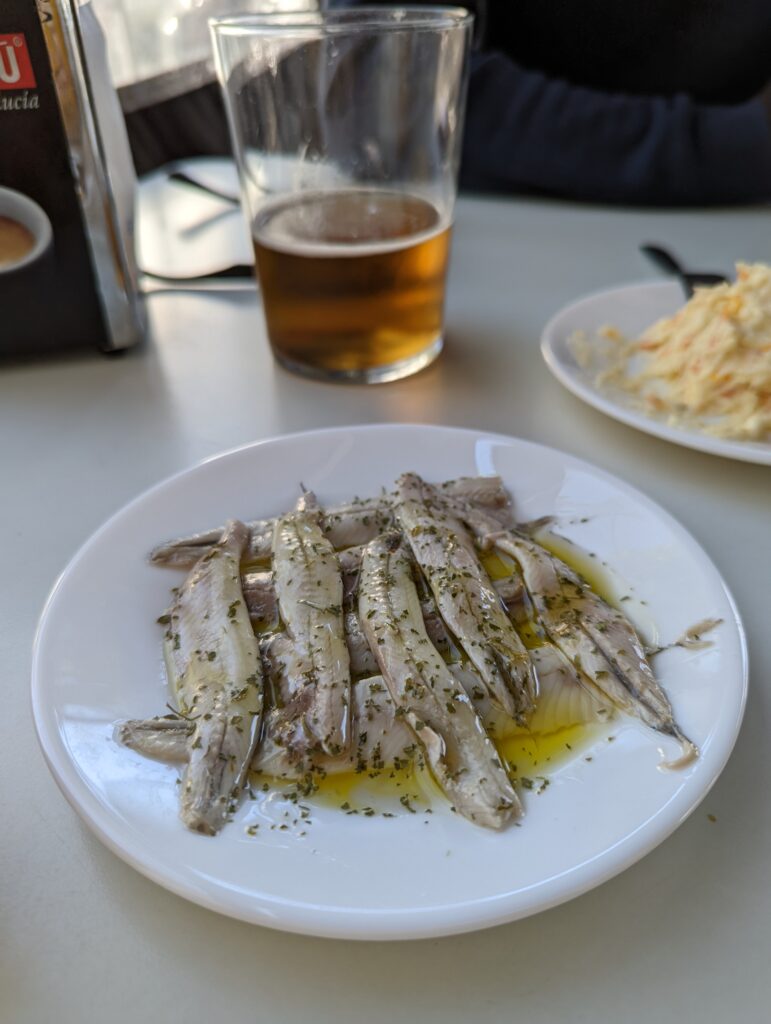
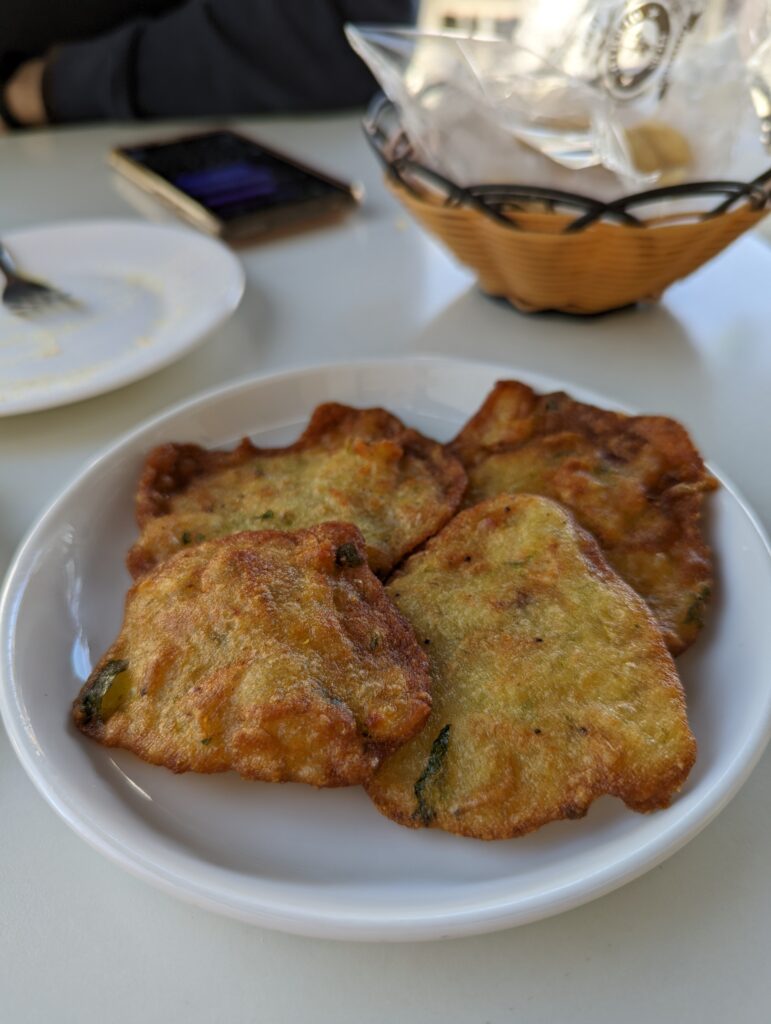
We had three tapas portions of ensaladilla (€2.20), boquerones aliñados (€2.50) and tortillita de camarones (€2.30) and it was just enough to tide us over until the next meal (or so we thought). Ensaladilla was fatty and creamy, anchovies were salty and vinegary, and tortillitas, sadly, had a little bit too much dough and not enough prawn for my liking but since this was the first of (probably) five hundred tortillitas we had, it was fine.
Bodegas Lustau, calle Arcos, 53, 11402, Jerez de la Frontera
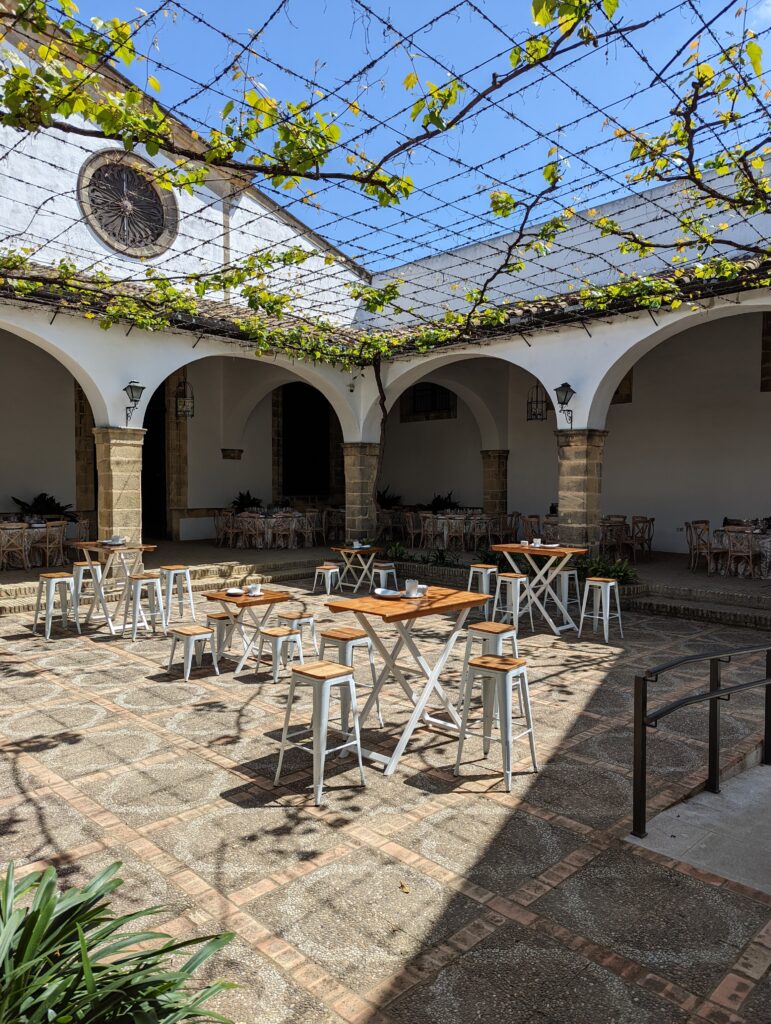
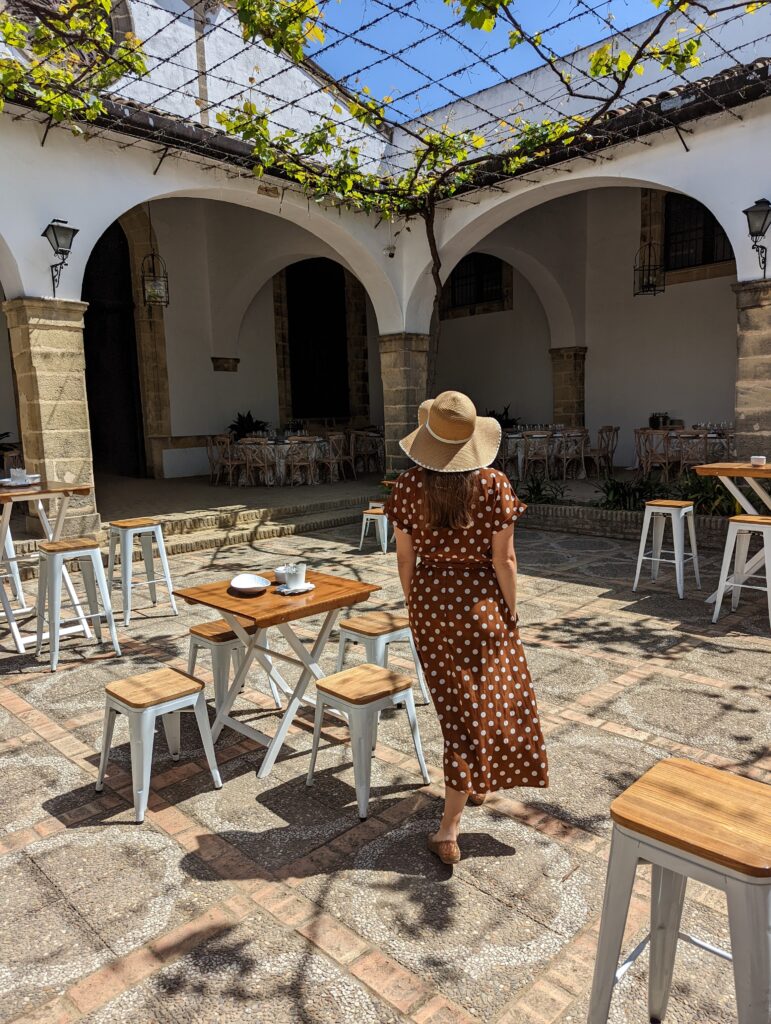
Bodegas are the raison d’être of your visit to Jerez. The city is alive with sherry production and most of the wineries are open for you to visit. Initially we had picked two of the biggest wineries – Tío Pepe and Lustau – for our visits (I would have done more but I am too old to start drinking sherry at 10 AM and yes, that is as early as you can start your sherry tastings). Anyway, I only later noticed that Tío Pepe changed the time of the tour, so I scrambled to book another one, cue Bodegas Tradición that I will talk about later. This scheduling debacle sorted out, we started with a lunchtime visit to Bodegas Lustau. We came a little early and had some time to kill in this beautiful courtyard, so of course Instagram pictures were taken.
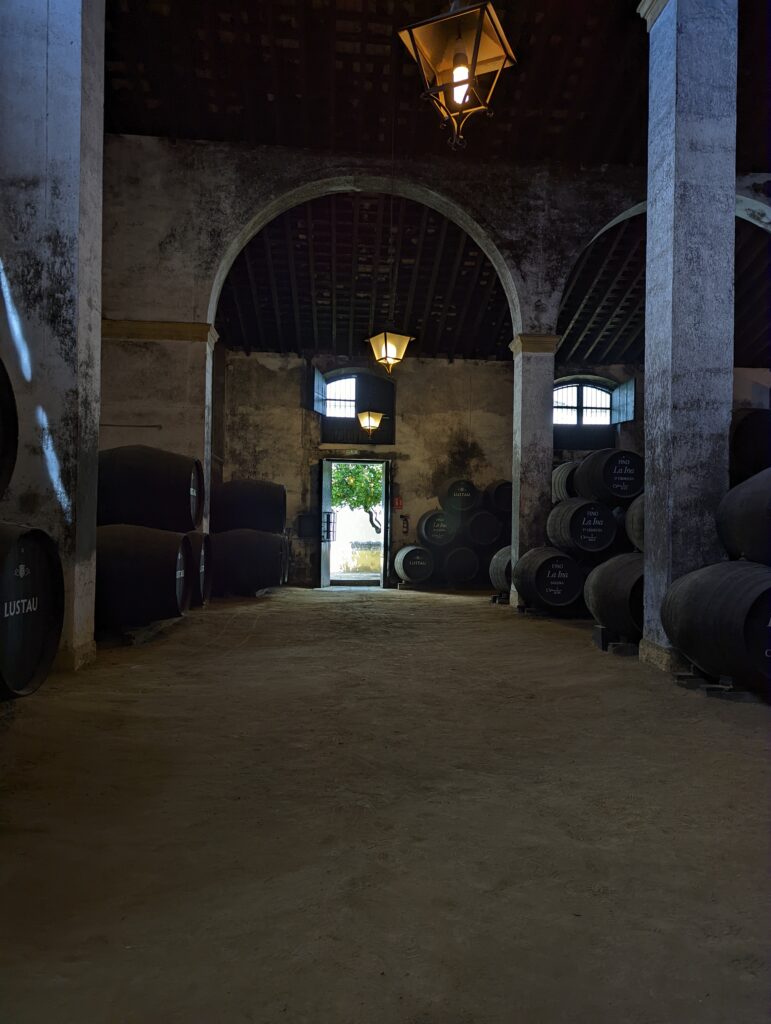
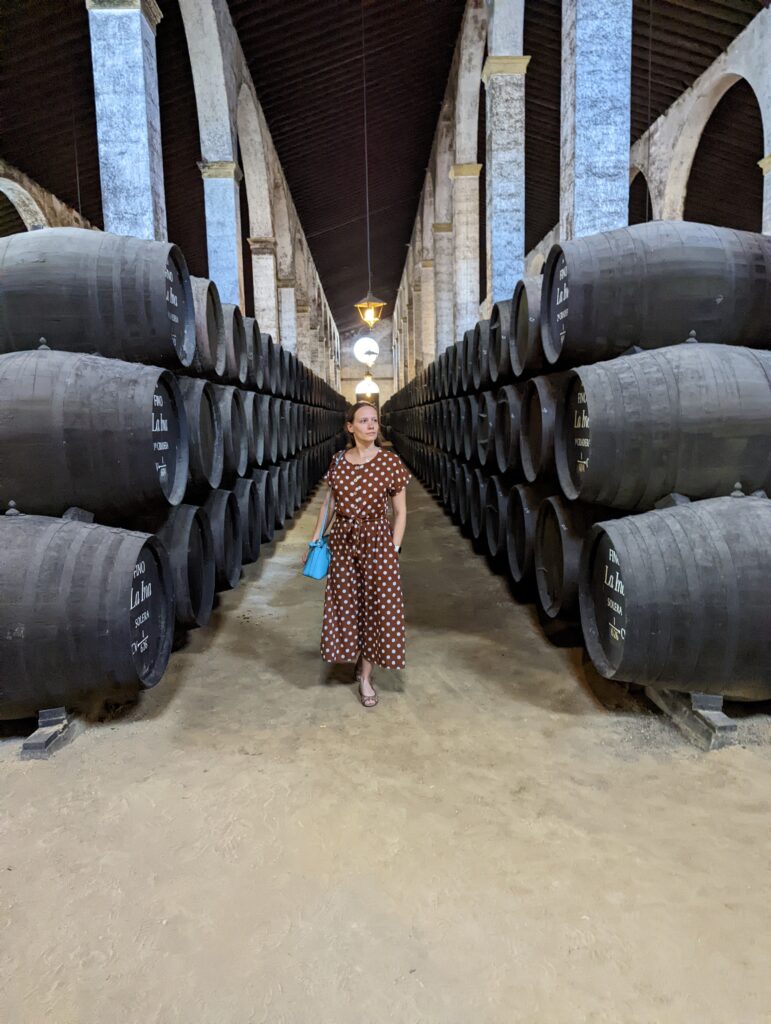

We started our tour with a glass of Amontillado sherry. It is one of the more complex sherries to explain because it goes through both biological and oxidative aging processes (I will try to explain them below). Since this sherry benefits from these both aging processes, it is a little bit more complex in its taste. It is also a little bit stronger at around 17.5% than your usual biologically aged sherry which measures at around 15.5%.
While we sipped on our first drink, our guide explained some basics about making sherry. First of all, sherry needs the cool and humid climate to mature, so all sherry wineries have high cathedral-like ceilings. The heat rises and is vented away though the small windows up top. It was interesting to learn that one side of the windows is always closed off because that is the side that the warm wind blows through and no one wants it getting inside.



OK, so here we come to the explanation about the different ways of aging sherry – biological and oxidative. I have to tell you that I AM NO EXPERT when it comes to sherries because it is not my favourite drink but I can try to sum up a bit of what we learned in a few lines if you are at all curious.
Basically, all sherry production starts the same way. First of all, sherry is exclusively made from the white Palomino grape (unless we are talking about the sweet sherry, then it is made from the Pedro Ximénez variety – PX). One of the more interesting facts that we have learned was that none of the sherry wineries have their own vineyards! Palomino grapes are grown, picked and processed into mosto (grape juice) and then turned into young wine by winemakers not sherry makers in the region. The sherry bodegas then buy the amount of the young wine they need and use it to make their sherry. We were told that this young Palomino wine is quite bad, hence, it all goes into the sherry production!
Basic dry sherry is called fino (or manzanilla if it is made in Sanlúcar de Barrameda) and is produced by using biological aging. For this biological aging process to happen, the casks are only filled to 2/3 of their capacity (check the picture above). The second young wine is poured into the barrel, a veil of yeast only found in Andalucía starts to form on top. This layer of yeast is called flor and it stops the young wine from oxidising creating a favourable environment for fino to age.
At this stop we tried three different fino sherries. I immediately did not like the first one – it was to briney, too mineral, too “salty”. The next two sherries were all right but still had a varying degree of the aforementioned qualities, just a tad more subdued. After we finished the three glasses the guide looked at us coyly and asked: “What if I told that you just had the same sherry in all three glasses”. At this point I was ready to fight and tell her “no way!” since the first one was so bad (in my humble opinion) in comparison to the other two.
There was no grand scheme to dupe us though. For sherry to be classified as sherry (D.O. Jerez-Xérès-Sherry) it has to be made in what is known as “The Sherry Triangle”: Jerez de la Frontera, El Puerto de Santa María or Sanlúcar de Barrameda. Bodegas Lustau is the only bodega to have wineries in all three and we just tasted fino sherries produced in each. As I mentioned above, Sanlúcar de Barrameda is a special case and they do not call the fino produced in that area fino, they call it manzanilla which has its own protected designation of origin, namely, D.O. Manzanilla Sanlúcar de Barrameda under the umbrella of D.O. Jerez-Xérès-Sherry.
So we have literally just had two finos and one manzanilla that were made in the same exact way (from the same young wine, under flor, in the same type of barrels, for the identical duration and so on). The only difference was climate! Sanlúcar de Barrameda is located on the Atlantic Ocean and benefits the most from the seaside climate, hence, the brininess, the minerality and the saltiness in the taste. While Jerez de la Frontera, for example, is located 12 km from the shore and has much different qualities! That was such a revelation and also very useful information as I now know which sherry I like the least. *laughs guiltily*

We have not even scratched the surface of sherry production. I described the biological aging process but there is also the oxidative aging process that produces sherry known as oloroso (“fragrant”). The young wine that has a little bit more boldness or character is put into the barrels and fortified by adding alcohol to reach around 17.5%. This stops flor from developing and the wine can age oxidatively. By the time of bottling, oloroso can reach up to 22% in alcohol content.
If you remember from above, we have started our tasting with Amontillado which is neither fino nor oloroso. Amontillado starts like fino (biological aging under flor) but this process is purposefully cut short by introducing more alcohol to kill off flor so that the wine can continue aging oxidatively.
If you think this is complicated, try adding Palo Cortado to the mix! Palo Cortado occupies a very small part among the sherries (maybe 1% or 2%). It starts as a fino or amontillado, meaning it starts with a biological aging process under the layer of yeast. Palo Cortado is developed when the flor spontaneously “decides” to stop growing and the sherry begins oxidating which would make it go bad if not attended, so it is then fortified with additional alcohol to around 17.5% to make sure it does not turn into vinegar. Palo Cortado sherries are very dry and nutty, have a lot of “nose” and are usually more refined and more complex.
Are you tired already? I cannot hear you, so I will assume no. This will be breezy! All sherries (biological and oxidative) are aged with the solera-criadera system. Basically, it means that the barrels are stacked on each other in rows. The oldest sherry barrel is on the bottom (solera), and then the next row (criadera) holds sherry from the same year and you can stack as many criaderas as you want.
Almost exclusively no sherry can be dated because what solera-criadera system means is that while sherries are aged, every year there is some sherry bottled (they are not allowed to bottle entire barrels, only 1/3 of the barrel), so the same amount that has been taken from the bottom barrel is filled from the barrel above. And the barrel on the second row is filled from the barrel on the third row. And when we get to the top barrel (which could be 3rd, 4th, 5th or even 6th), the young wine is added to start the aging process. Complicated? You bet!


Unlike what I remember from my time in the UK (sweet sherries, never liked them), 99% of sherries made from Palomino are dry. Cue Pedro Ximénez grape variety which makes for the sweet sherry! PX sherries are very sweet, usually thicker in consistency reminiscent of port more than the regular sherry. There is also something called cream (kre-am) which is a semi-sweet wine produced by mixing oloroso (oxidative aging) and PX.
And this is it on sherry production! I hope you enjoyed this little oenological lesson. Really, I bet you hate me. Thank you for coming to my sherry TedTalk, I will never write again.
Ah, but one last fascinating thing! Most of Lustau’s sherry production is destined for export. In what Bodegas Lustau call their “chapel” (remember the reference to the cathedral?), they hold a bunch of barrels (maybe 20) with the insignia of the countries that are their most important importers. Guess what I saw amongst them? Lithuania! Very unexpected as I have never pegged Lithuanians as much of a sherry drinkers. Next time I am visiting, I will pop into a few wine stores to look for Lustau sherries!
Bar La Manzanilla, calle Veracruz, 2, 11402, Jerez de la Frontera
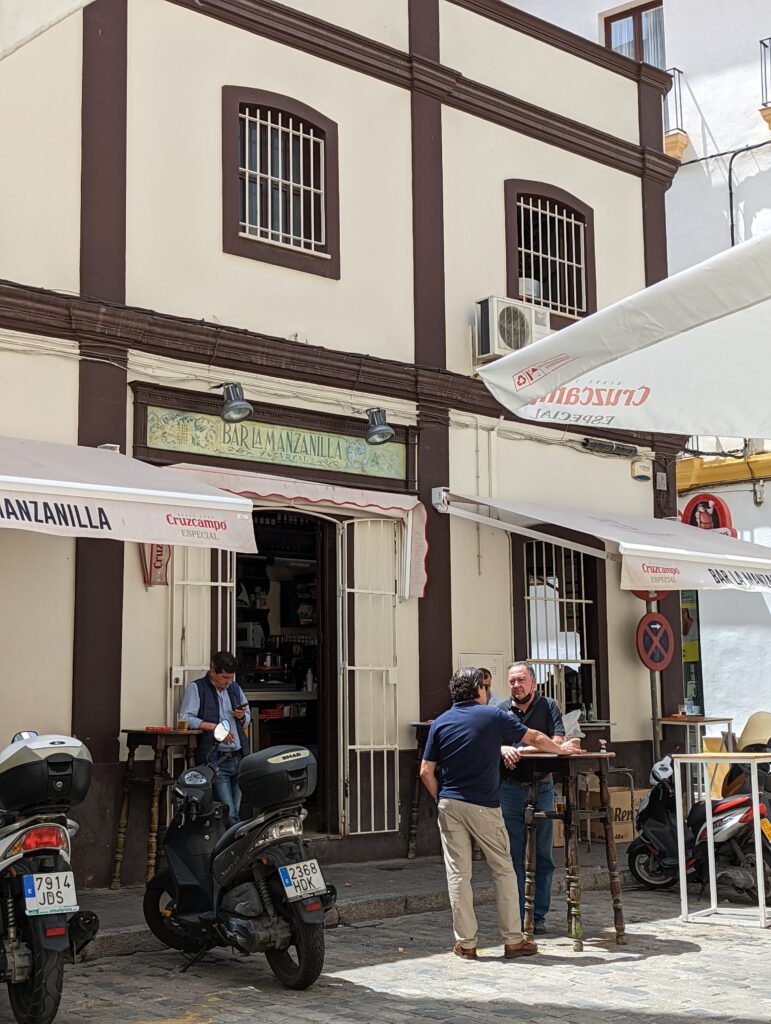
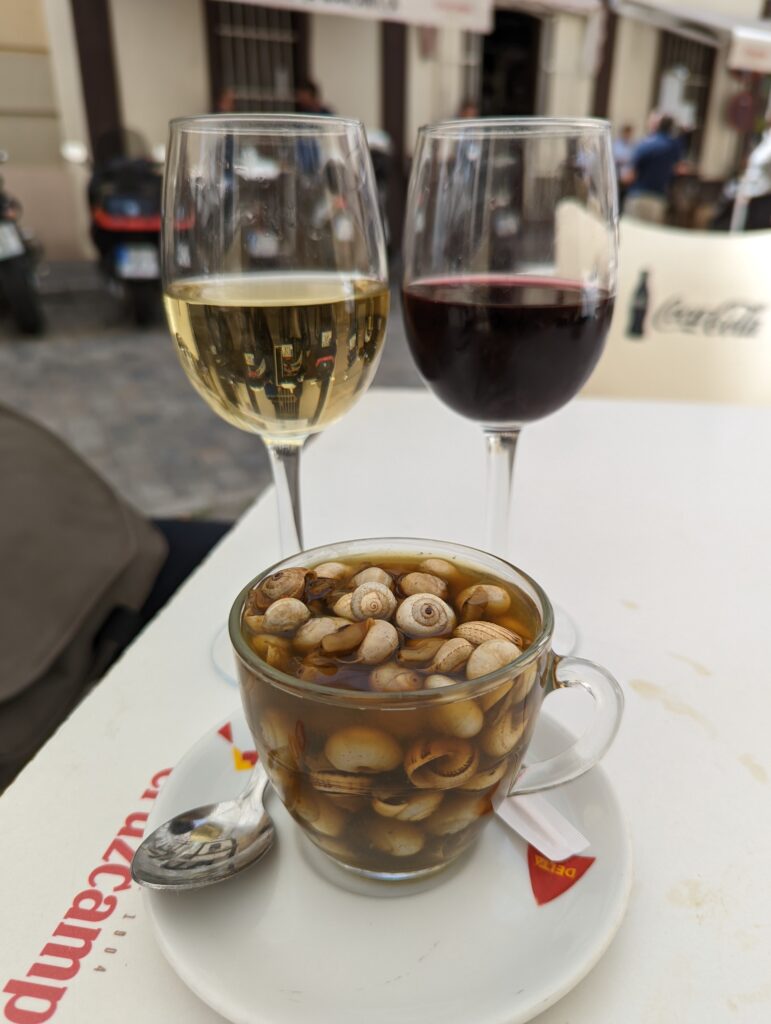
We were innocently walking by when Matas told me he is curious about what all of these people were eating out of these cups. So of course we had to stop and check. Turns out these were snails (this was my second day in the row eating snails by the way)! Apparently, these baby snails are in season and they were also sold all over the streets of Jerez 5 kilo bags a pop. We shared a cup and did not even manage to finish it. The snails are too tiny: too much work for too little reward. Although the broth was incredibly flavourful and I really liked it!
Bar Juanito, calle Pescadería Vieja, 8, 10, 11403, Jerez de la Frontera
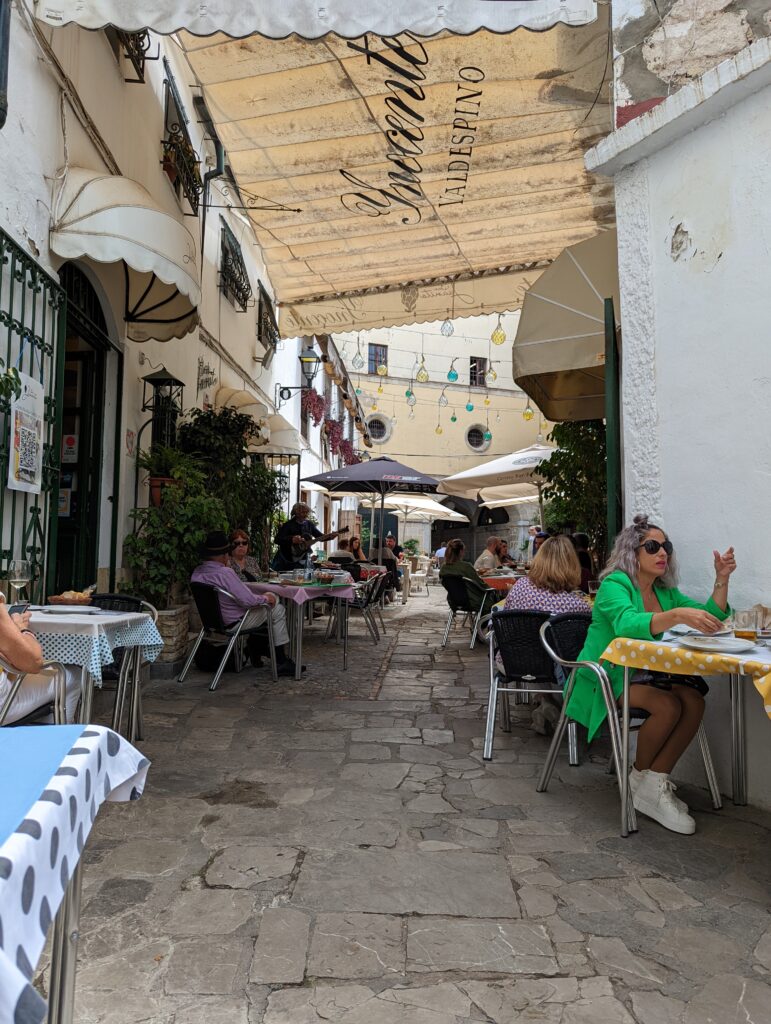
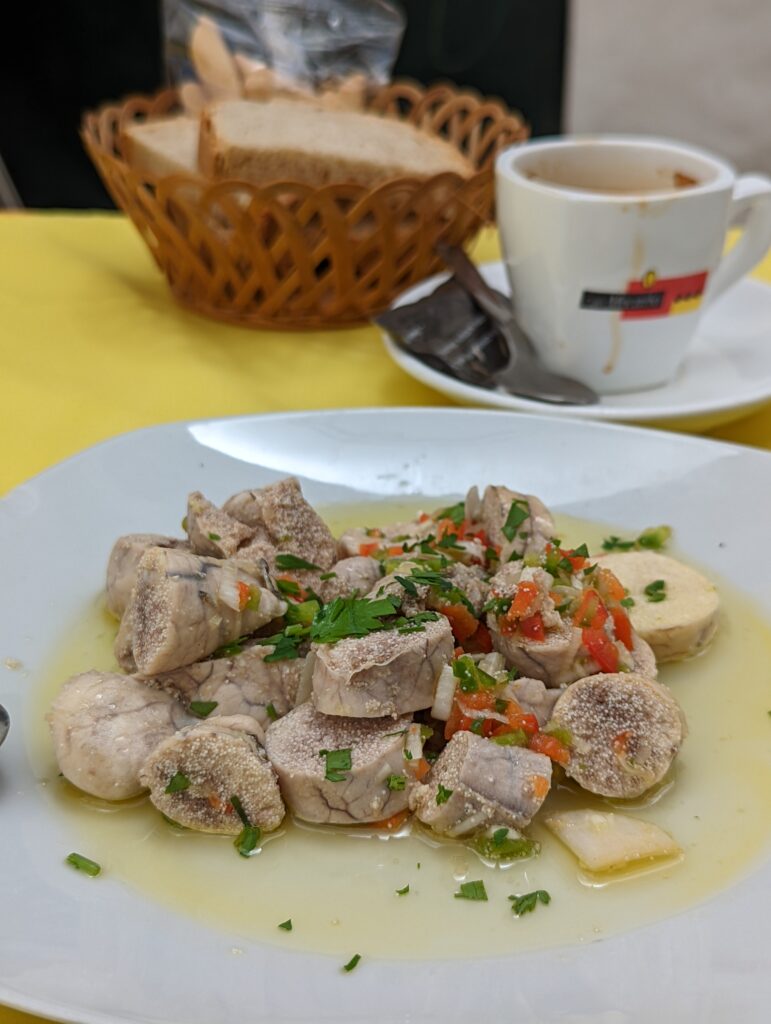
I initially ordered a bunch of food for us but the service was very slow and we needed to get to our next sherry tasting soon, so we only got to try the seasonal fish roe – one of the specialties of the region. This appetiser was served cold, the eggs were grainy (as they should be) and the taste was quite good, especially with the slightly marinated fresh salsa served on the top that had that light acidity from tomatoes and a bit of the bite from raw onion.
Bodegas Tradición, calle Cordobeses, 3, 11408, Jerez de la Frontera
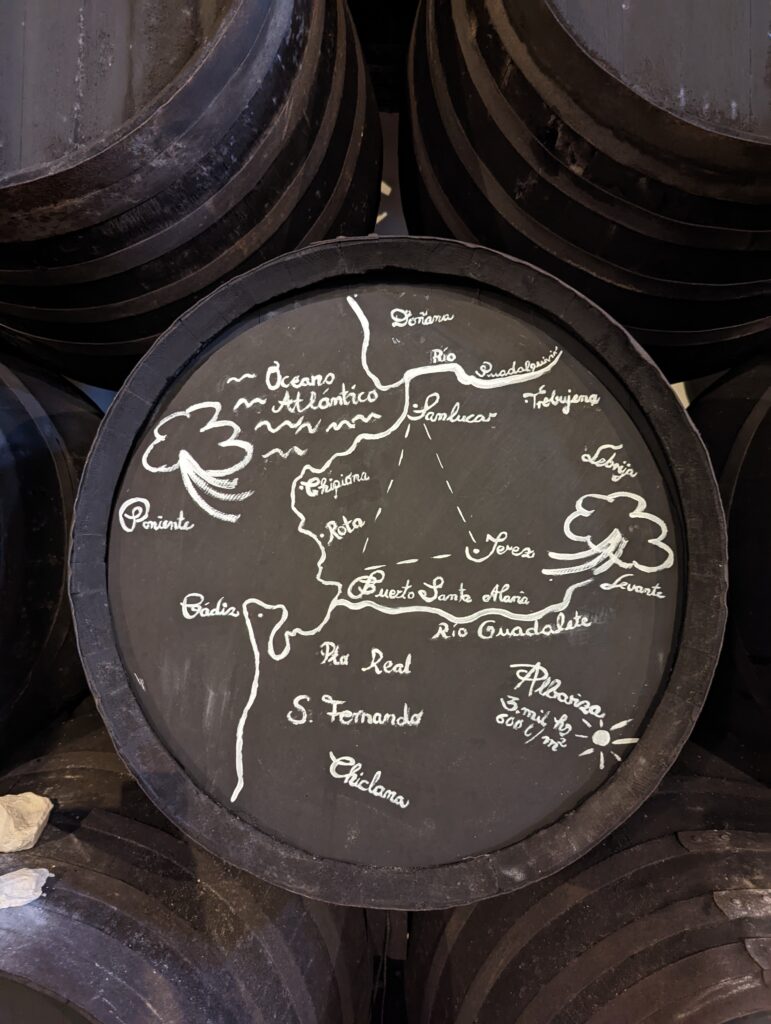
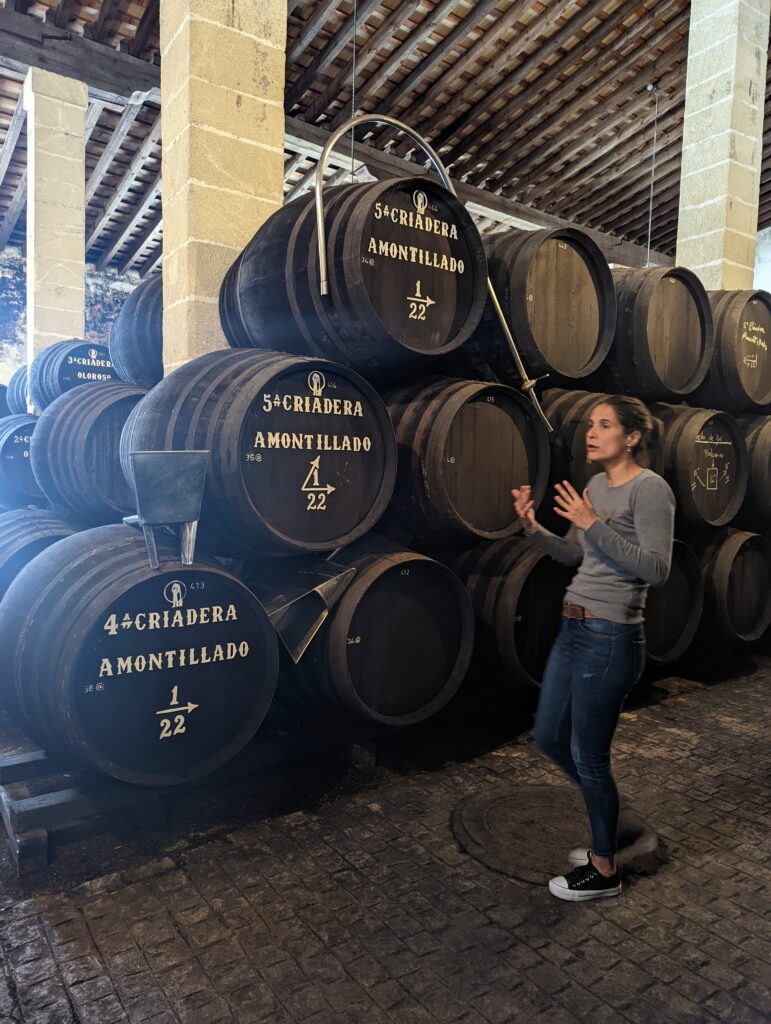
We had no time to have a late lunch because our next winery tour was starting soon. In comparison to Bodegas Lustau Bodegas Tradición is a very small winery. Not only they are small but they are also relatively new to the sherry making game having “only” opened in 1998. Despite the fact that they are a very young winery, they only produce sherries that have a denomination of VOS and VORS. What does this mean?
In Latin VOS stands for Vinum Optimum Signatum or Very Old Sherry while VORS stands for Vino Optimum Rare Signatum or Very Old Rare Sherry. In order to be awarded VOR, the average age of sherry (remember, sherry cannot be dated precisely as it goes through the solera-criadera aging process) has to be more than 20 years in average. In order to be awarded VORS, the sherry has to be more than 30 years in average. So how can a winery that has only been open for a bit over 20 years starting producing VOS and VORS from the beginning?
The history of the family that owns Bodegas Tradición is incredibly rich and it started in the 1650s. To make a long story short, the original bodega was operated up until mid-XIXth century when it was *unwillingly* sold! The family then became industrialists and capitalists and amassed a small fortune, however, it took until 1990s when one of the descendants decided to rekindle his sherry making roots and bought a bunch of very old (cannot be dated) sherry casks off of another foreclosing bodega and started making his own sherry.

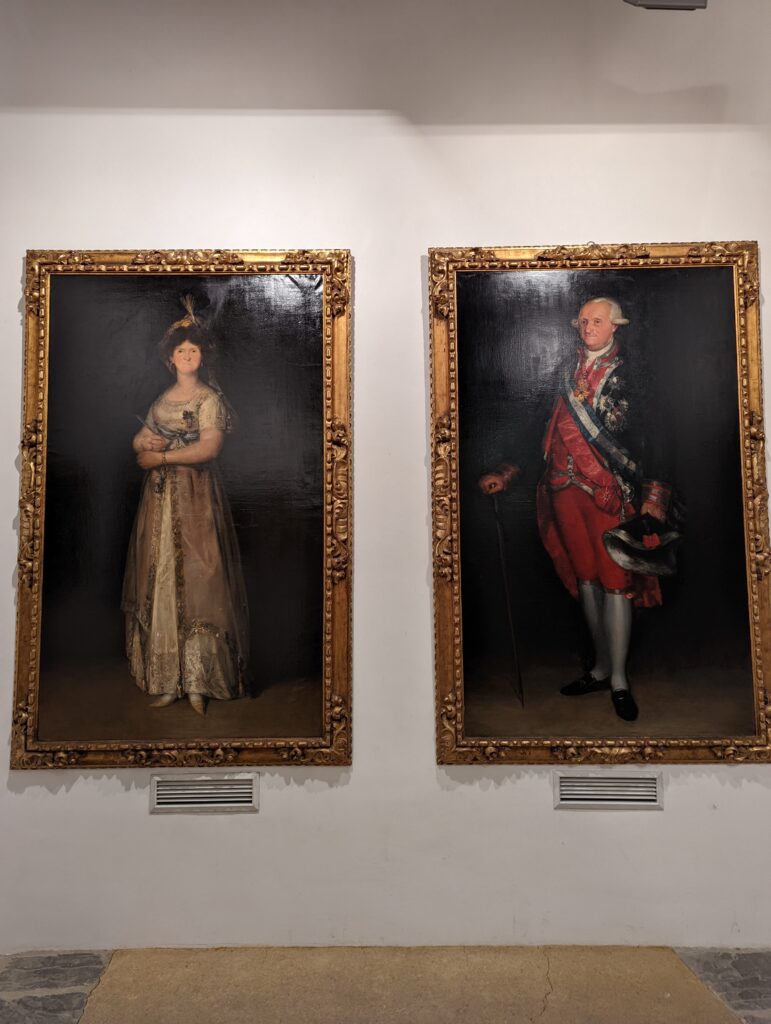
Remember I told you this family is rich? Well, not only this family produces a high quality rare sherries, they are art collectors too and they have a “small” museum with 60 works of art from their collection on the premises. Velázquez, Goya, Sorolla, Zurbarán and others grace the walls and you get to enjoy all of it while sipping on a glass of excellent cream (kre-am!).
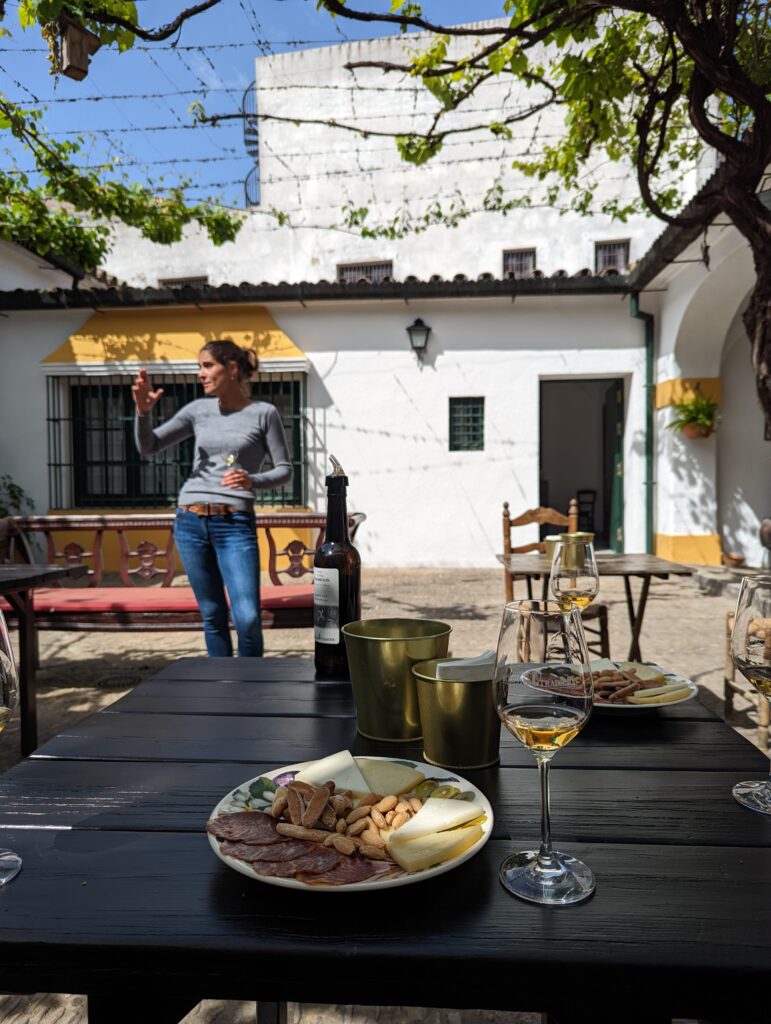
We absolutely loved visiting this and Lustau wineries (and would have visited more if only we had time). I did not much like sherry before visiting Jerez and I for sure could not appreciate it. Learning about how unique and special sherry is was truly an eye opening experience and I am sure I will have much more appreciation for the drink from now on.
Churros Plaza de Jerez, near Mercado de Central de Abastos

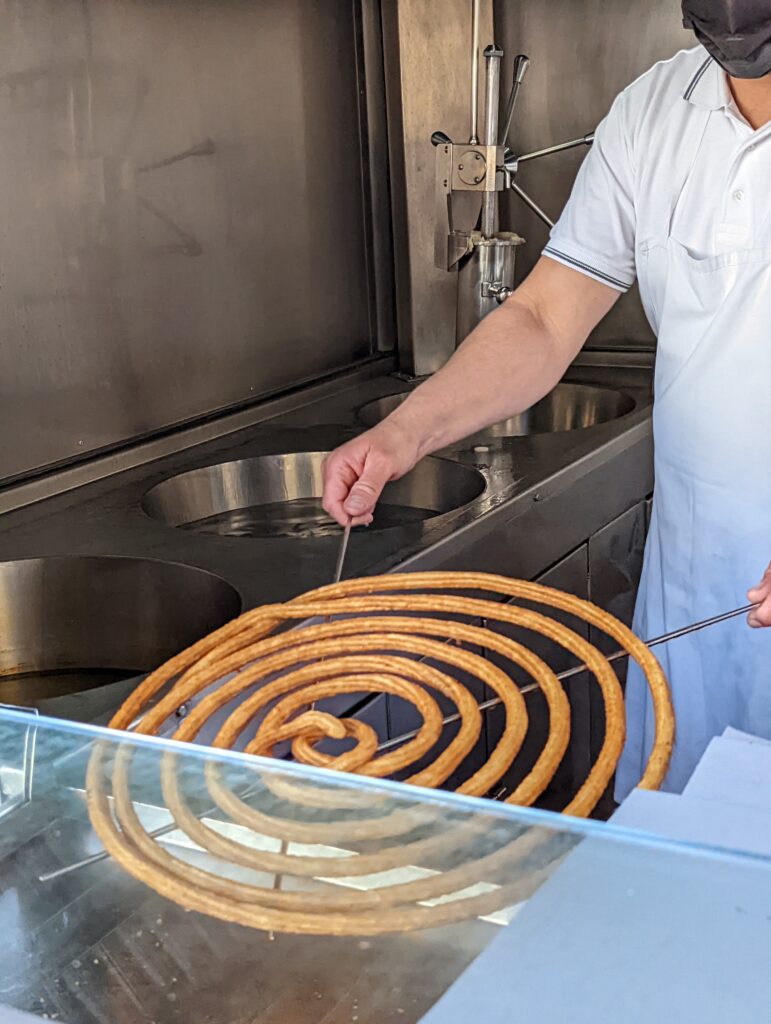

We go from sherry to churros! Another day dawned and I promised Matas we will get churros. Initially, I wanted to go to the same place we had churros the morning before but our more adventurous nature took over and we decided to try a new place.
This little kiosk settled smack dab in the middle of the market square had fresh churros to go. You could buy one kilo if you fancied! We settled on the smallest available amount and received about half of that big round churro ring in a paper cone. It also cost something ridiculous like €1 (try getting churros this cheap in Madrid). These were not as good as the churros we had the day before. If those churros were salty, thin and crispy, these were more tradicional, a little bit thicker and eve if literally prepared a minute ago, had a bit of an oily taste.
Kiosco El Lobo, near Mercado de Central de Abastos
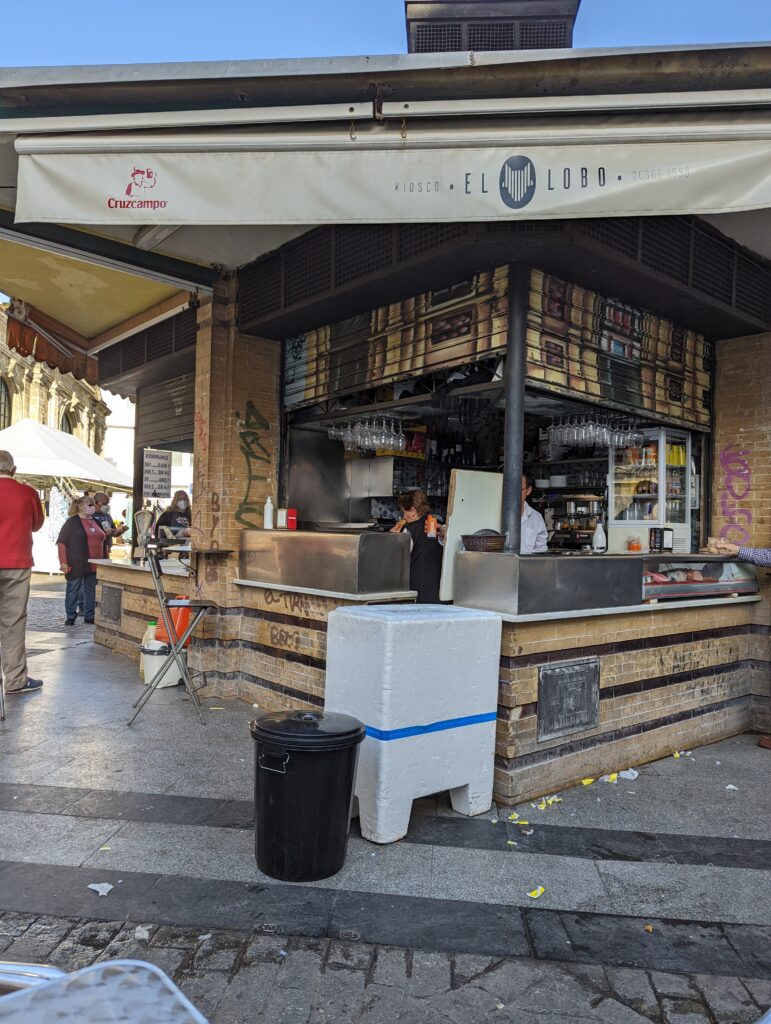
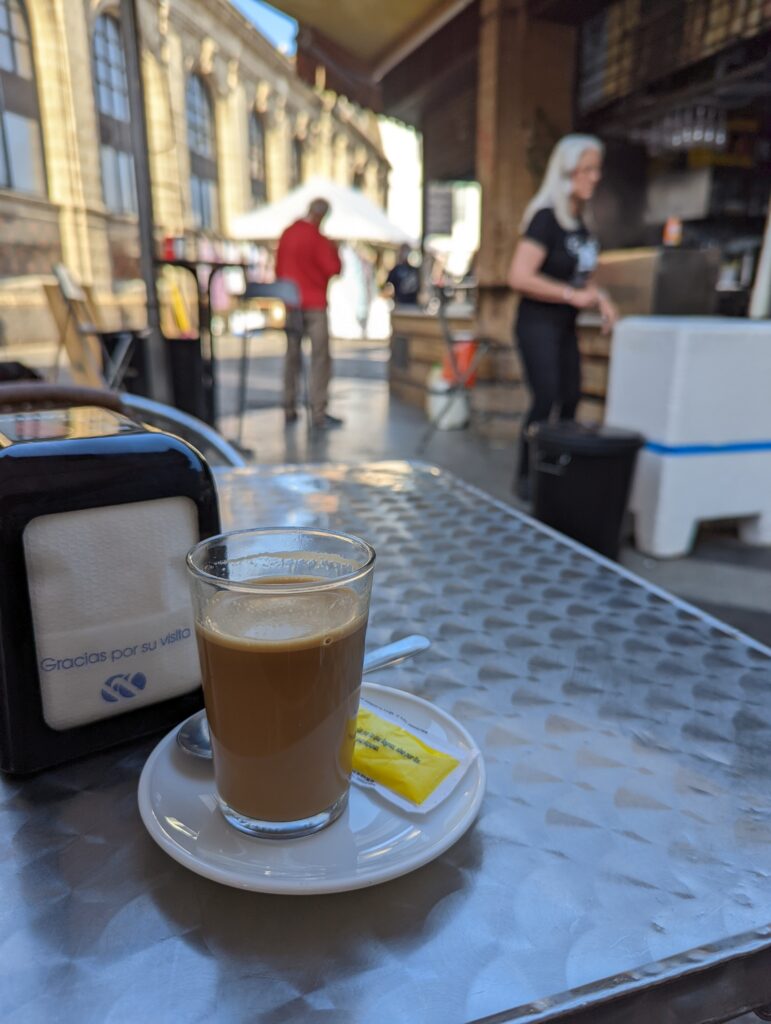
With a take away churros cone in hand we were on a lookout for a place to sit. A local saw us looking around and motioned us over to a table nearby. As luck would have it, the table we ended up at served coffee and did not mind us having brought our churros. Win win.
Mercado Central de Abastos, calle Doña Blanca, 8, 11402, Jerez de la Frontera
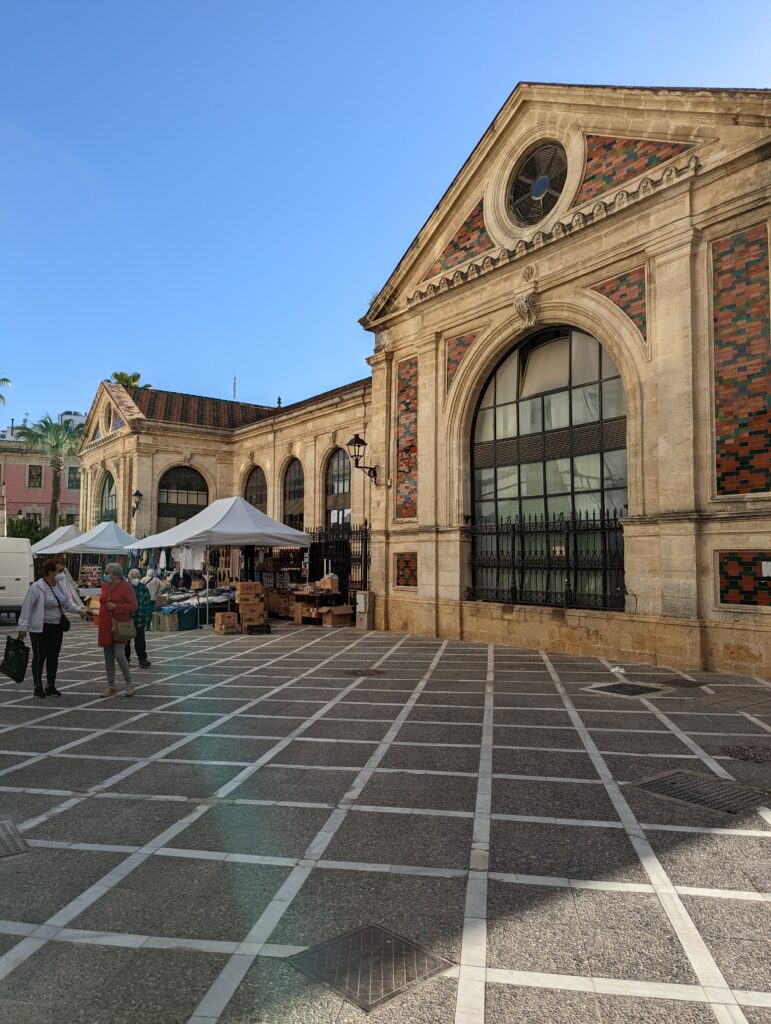
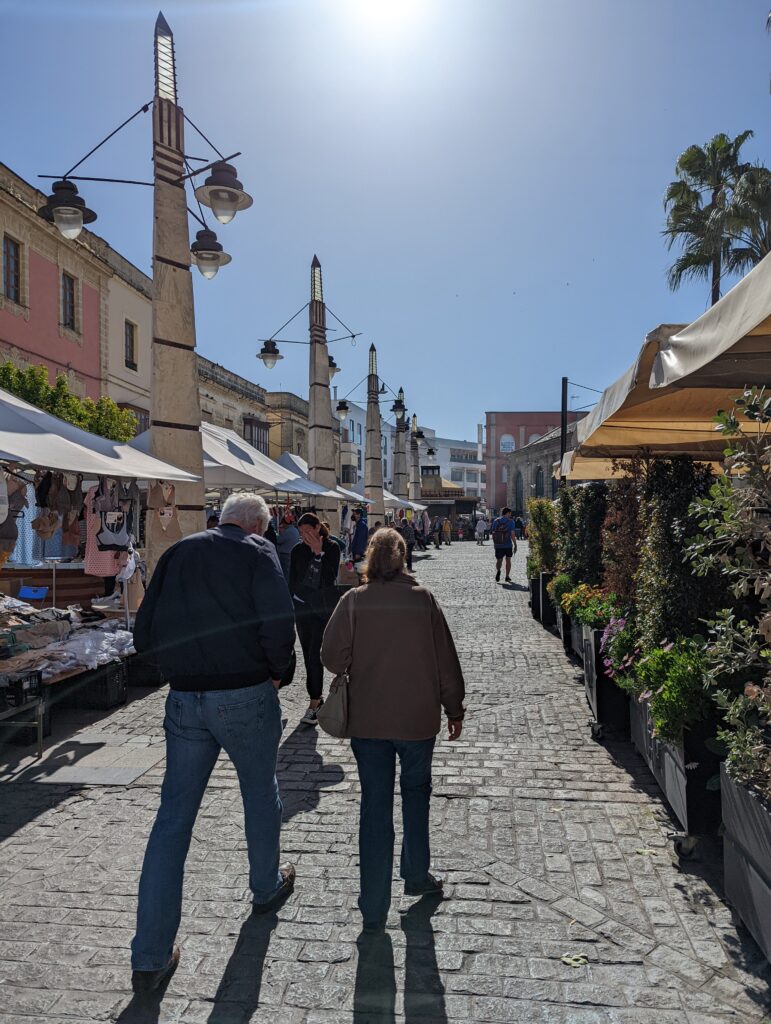
It was really fun just to sit back, relax, munch on a churro and observe the hustle and bustle of the market square. Coffee orders were flying left and right, most of it being hand delivered into the market for stall operators. Sandwiches were being prepared and dished out, one proprietor coming after another to pick up their breakfast. Sellers outside bustled, busked, shouted and waved while the rest of the people just wandered around soaking in the warm morning sun. Absolute bliss.
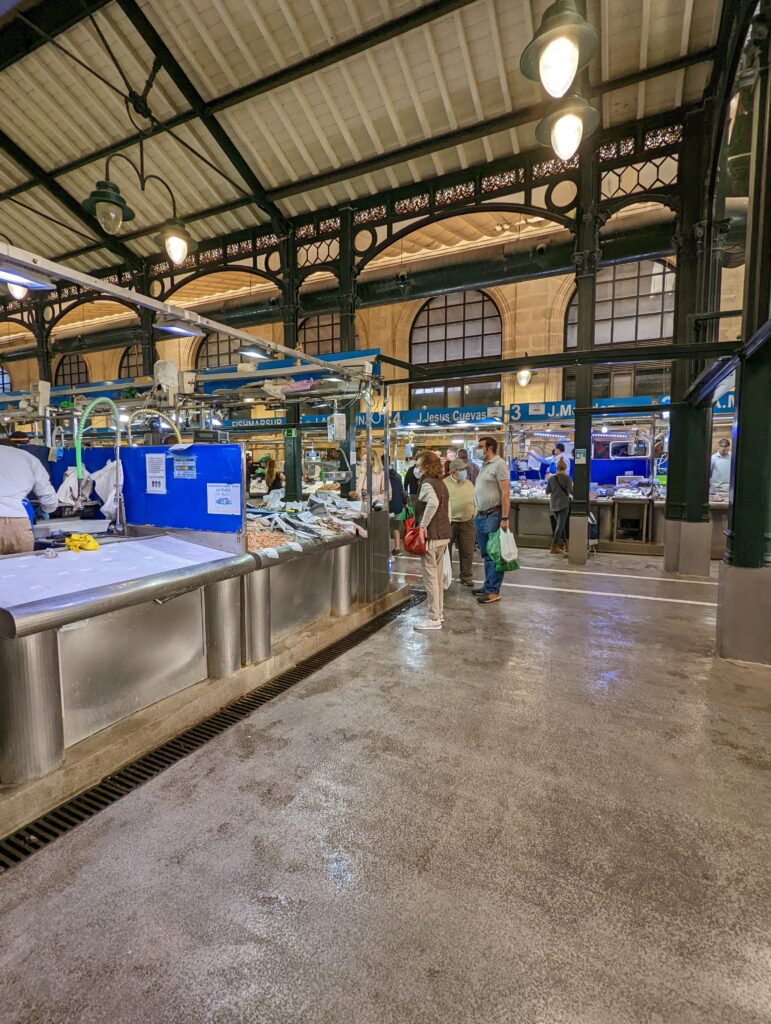
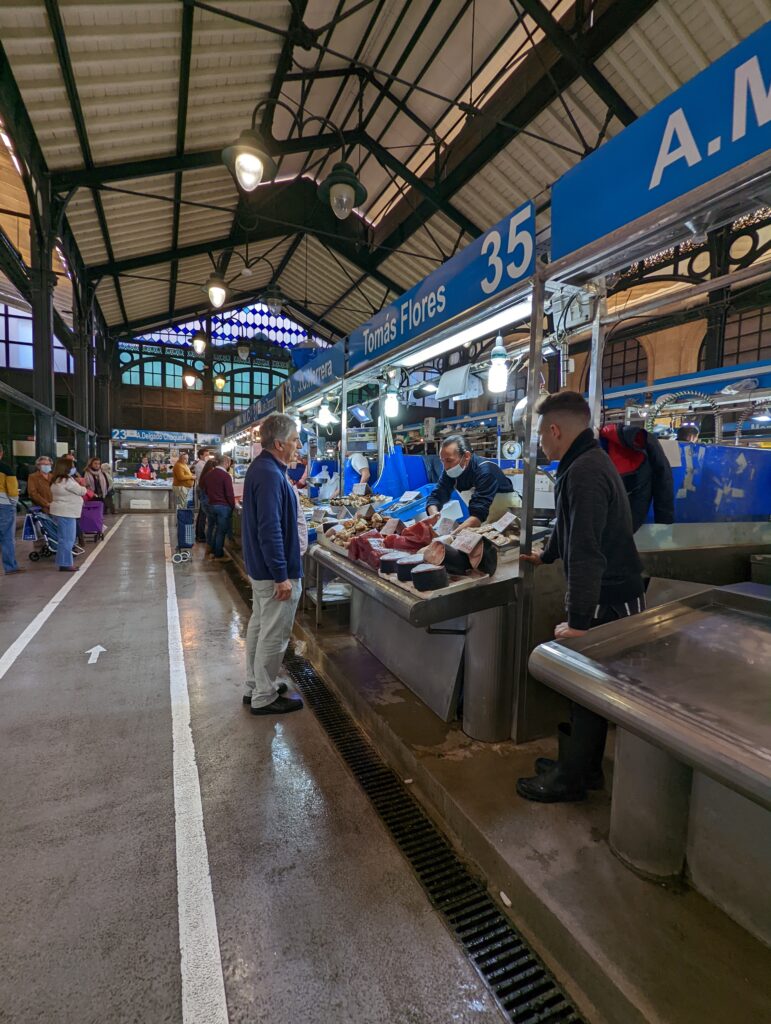
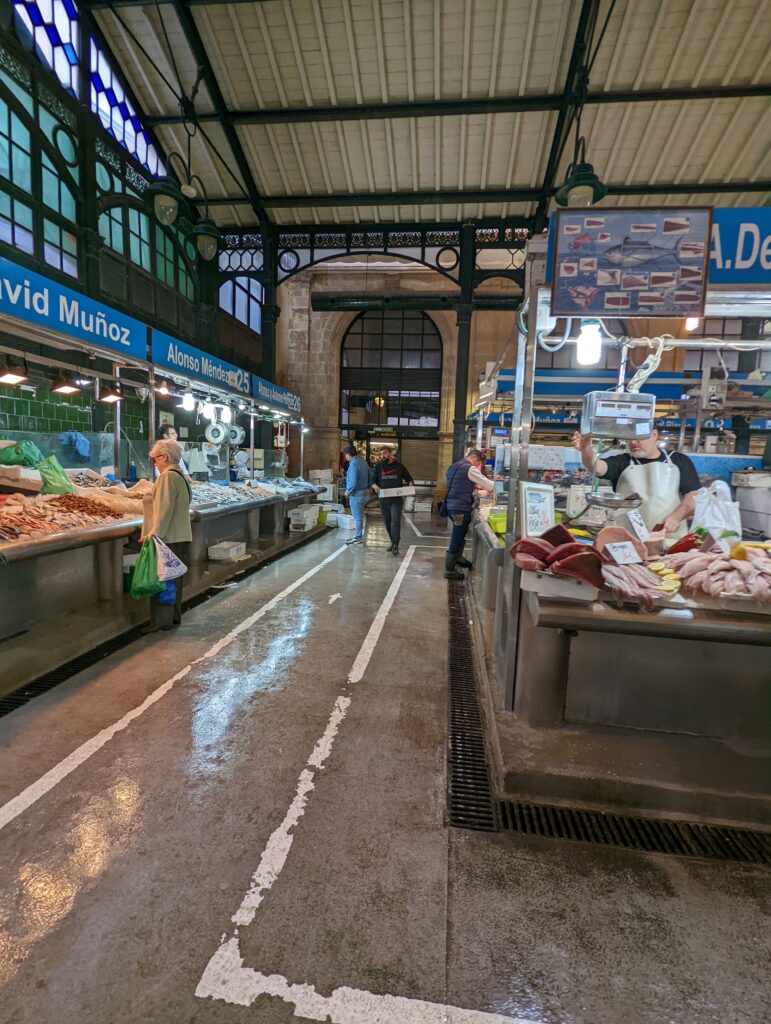
After finishing our breakfast we strolled through the market itself. Hands down this has been the largest seafood market I have ever been to in Spain. I have to admit that these are not the most representative photos of the seafood we saw but I did not want to get in vendors faces with my phone taking pictures left and right. We saw everything from percebes to dogfish, dozens of shrimps and prawns in all shapes and sizes, not to mention the abundance of fish, shellfish, and other sea creatures big and small. The area for fish was at least three times bigger than that of fresh produce! This is definitely a must visit in my book if only for a short once over stroll.
Alcázar de Jerez, calle Alameda Vieja, 11403, Jerez de la Frontera
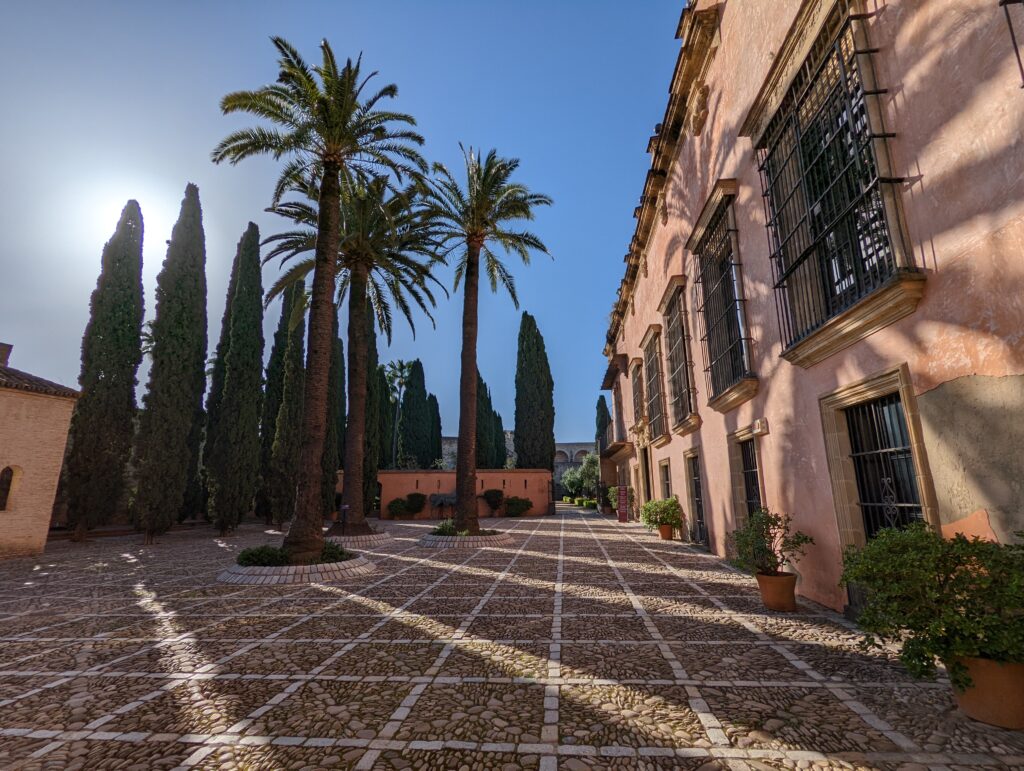
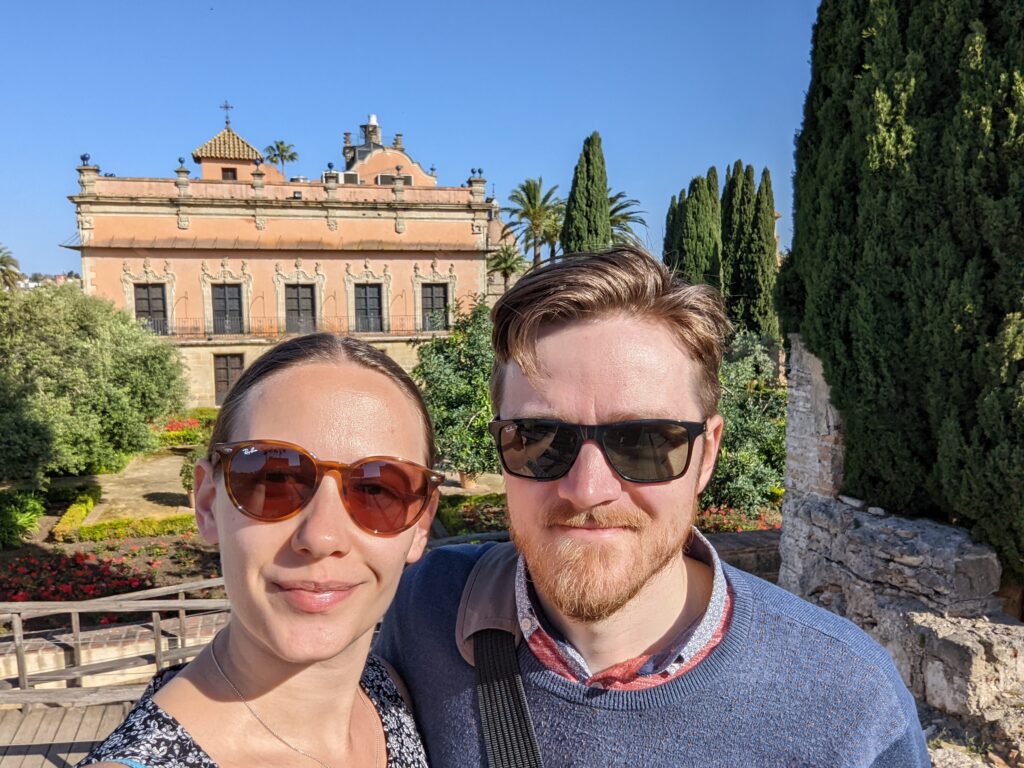
After the coffee and after the market and after a lazy stroll we came here on a Saturday morning half an hour or so after the palace’s opening time and there was absolutely no one inside. For the next hour we literally had this place to ourselves. And I definitely took advantage of it which you can see in the following pictures.
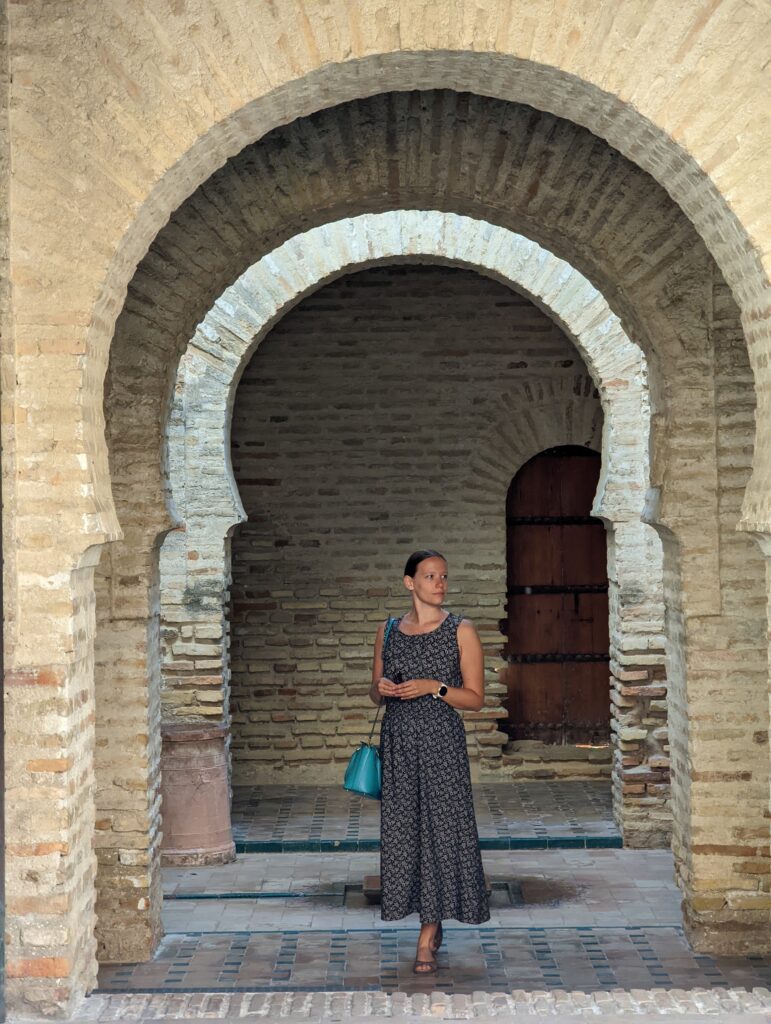

Another interesting tidbit for you – there is a lot of Moorish architecture left over from XI-XII centuries in Southern Spain. Alcazár means a castle or a palace (the most famous of alcázares being Alhambra in Granada). The first picture was actually taken at the entrance to the mosque part of the complex. Around this part of Andalusía there are also many towns named <…> de la Frontera. It means these towns were on the border of the region occupied by Moors.
The beauty of this complex aside, Octagonal tower comes with a morbid story to boot. Matas and I were chatting and just about to enter the Octagonal tower when out of nowhere this cat zooms past us with a feral sound and (I kid you not) at the speed of light. I barely registered this orange blurb shooting by but the shrill sound it made literally chilled us to the bone.
Well, we enter the tower and what do we see on the ground? A headless pigeon in the midst of being devoured – blood and feathers everywhere. We later walked by the actual scene of the crime where we saw some drops of blood and more feathers. Sorry, gato, for having interrupted your lazy Saturday breakfast.
The funniest bit was when I went to warn the girl at the counter of what is waiting for the next visitors, the exchange in Spanish going like: “I don’t know how to say this but Octagonal tower – cat – pigeon – death.” She actually laughed, so I guess that must happen on the regular. Oops, sorry for being so morbid…


Anyway, this palace complex is truly amazing. There are Moorish remains of the mosque, the hammam and there is also another palace built in Baroque style dating from 1650s. You can go inside and it is not very crazily decorated as you would expect from a Baroque palace but there is an old school pharmacy that has been recreated, so that is awesome. And, of course, we spent quite some time just walking in the gardens which were so green and peaceful.

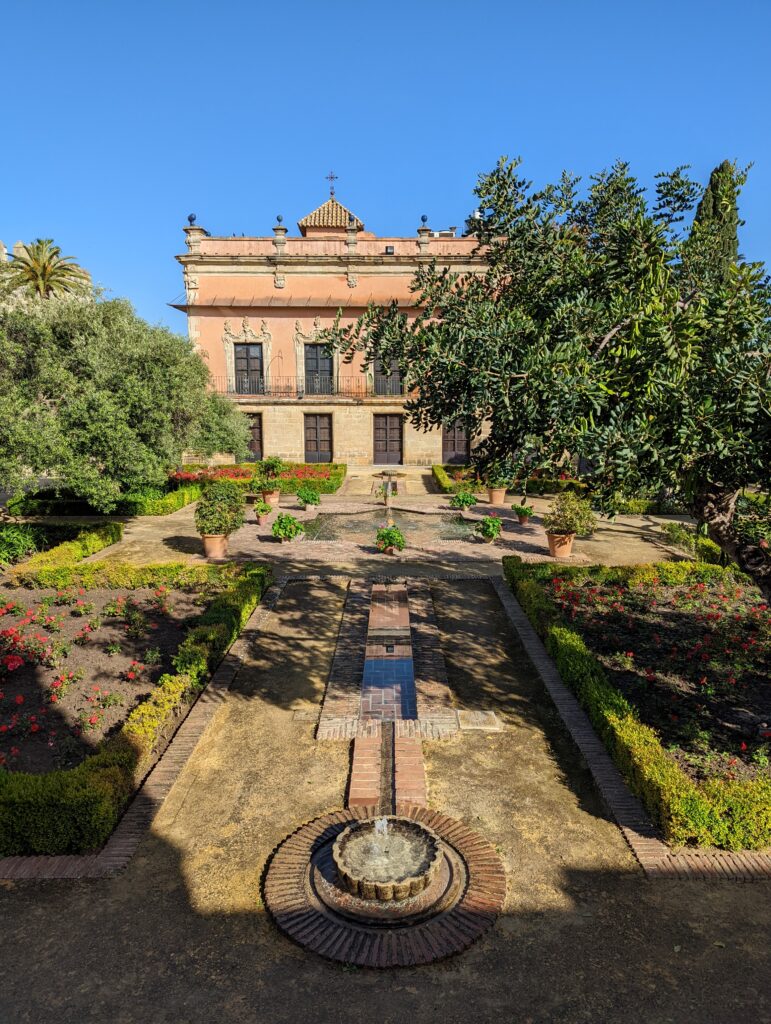
I would come back to Jerez in a heartbeat! Our stay this time was very short but it did not stop me from falling in love with it. By all rights, Jerez should be a tourist destination (the bodegas and all) but it did not feel this way at all. We spent Friday to Saturday mornings here and after Madrid the pace immediately seemed slower, the city felt like it was going by the rhythm of its own without any throngs of tourists pushing by. Andalucía has captured my heart for the moment. Such a marvelous place on Earth.

2 responses to “24 magical hours in Jerez de la Frontera”
1. Amontillado reminded me the most terrifying (in my humble opinion) short story by E. A. Poe about a man being bricked alive in a cellar for nothing 2. That glass of snails… The first time I saw a picture I thought these snails to be eaten with shells 😀 3. You look gorgeous in that dress
1. I think I need to reread it with a newfound appreciation.
2. Honestly, that would have saved time.😀
3. Thank you.😘